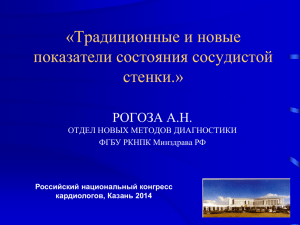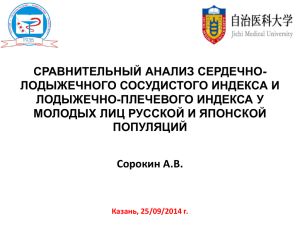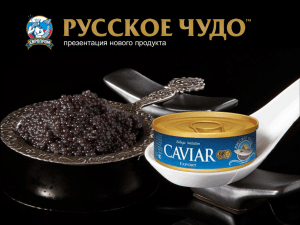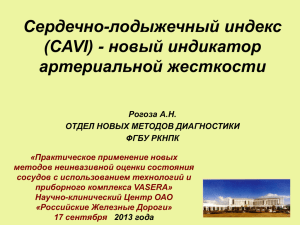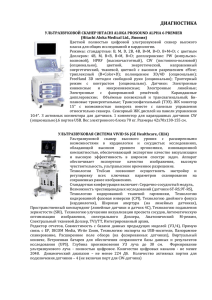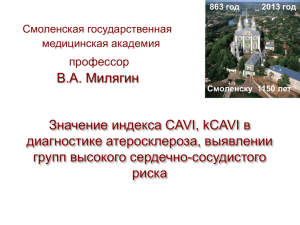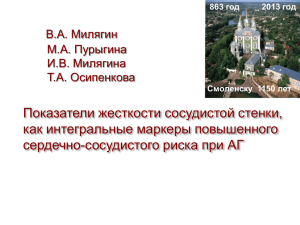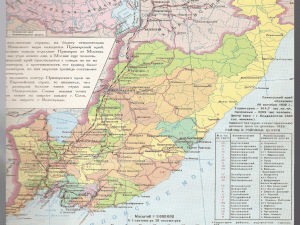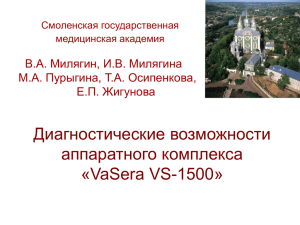Нормальные» величины CAVI для российской популяции.
advertisement
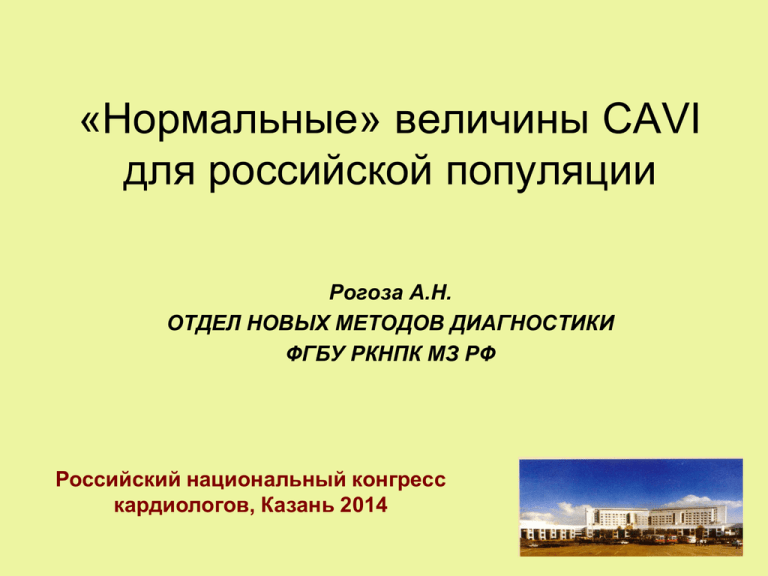
«Нормальные» величины CAVI для российской популяции Рогоза А.Н. ОТДЕЛ НОВЫХ МЕТОДОВ ДИАГНОСТИКИ ФГБУ РКНПК МЗ РФ Российский национальный конгресс кардиологов, Казань 2014 Выявление и терапия пациентов с высоким риском сердечнососудистых осложнений Инвазивные методы Интенсивность терапии Неинвазивные визуализирующие методы Скрининговые методы Жесткость артерий Общая популяция Expert consensus document on arterial stiffness: methodological issues and clinical applications Согласованное мнение экспертов ESC по вопросу артериальной ригидности: методические аспекты и клинические применения European Heart Journal 2006 27(21):2588-2605 • В настоящее время максимальное распространение получила методика измерения СПВ при расположении сфигмодатчиков над проекциями сонной и бедренной (в районе пупартовой связки) артерий. Соответственно для этой использоваться обозначение СБ СПВ. Для определения СБ СПВ по классической методике необходимо одновременно зарегистрировать две качественные сфигмограммы в указанных выше точках и определить задержку dt между моментами появления пульсаций в исследуемых точках сосудистого русла. Нейрософт, Иваново Согласованное мнение экспертов ESC по вопросу артериальной ригидности: методические аспекты и клинические применения (2006) • • • • Итоговое заключение. Измерения Жесткости аорты и центрального давления должны рассматриваться как рекомендованные тесты для оценки с-с рисков, • причем особенно у тех пациентов, где при обычном обследовании не выявлены поражения органов-мишеней. ESH 2007 ВНОК 2008 Исследования, рекомендуемые дополнительно при обследовании больных с АГ • • • • • • • • • • содержание в сыворотке крови мочевой кислоты, калия; ЭхоКГ; определение МАУ; исследование глазного дна; УЗИ почек и надпочечников; УЗИ брахиоцефальных и почечных артерий рентгенография органов грудной клетки; СМАД и СКАД; определение лодыжечно-плечевого индекса; определение скорости пульсовой волны (показатель ригидности магистральных артерий); • пероральный тест толерантности к глюкозе - при уровне глюкозы в плазме крови > 5,6 ммоль/л (100 мг/дл); • количественная оценка протеинурии (если диагностические полоски дают положительный результат); СПВ с учетом возраста и уровня АД!!!!! Февраль 2012 г . СПВ = 10 м/с 2010 ACCF/AHA Guideline for Assessment of Cardiovascular Risk in Asymptomatic Adults Developed in Collaboration with the American Society of Echocardiography, American Society of Nuclear Cardiology, Society of Atherosclerosis Imaging and Prevention, Society for Cardiovascular Angiography and Interventions, Society of Cardiovascular Computed Tomography, and Society for Cardiovascular Magnetic Resonance Recommendation for Specific Measures of Arterial Stiffness I IIa IIb III Measures of arterial stiffness outside of research settings are not recommended for cardiovascular risk assessment in asymptomatic adults. The writing committee felt that: A. Measurement protocols must be well standardized (Expert Consensus, 2012) B. Quality control procedures must be established. (VS1000, VS1500 – YES) C. Reproducibility is a problem, as method is operator dependent. (VS1000, VS1500 – NO) D. Riskdefining thresholds must be identified. (Real Problem for CAVI) K. Shirai, N. Hiruta et al, J Atheroscler Thromb, 2011; 18:924-938. Таблица 2. Показатели объемной сфигмографии в зависимости от возраста (MSD) Показ атель CAVI 20 лет 21-30 31-40 41- 51-60 61-70 >70 лет лет 50 лет лет лет лет 6,7 7,2 7,4 7,55 8,0 8,5 9,8 0,76 0,61 0,63 0,7 0,67 0,64 1,51 Показатель CAVI 20 лет 21-30 лет 31-40 лет 41-50 лет 51-60 лет 61-70 лет >70 лет 6,7 0,76 7,2 0,61 7,4 0,63 7,55 0,7 8,0 0,67 8,5 0,64 9,8 1,51 Признаки повышенной жесткости стенки магистральных артерий • «Возрастные Пороговые» значения • До 30 лет • 30-40 лет • Выше 40 7.6 8.3 9.0 “ЭССЕ-РФ" 6 November 2012 – 1548 report of VaSera VS-1500 collected in Cardiology Research Center, Moscow, Russian Federation Ivanovo St. Petersburg Vladikavkaz Tomsk 2000 2000 2000 2000 Tyumen 2000 participants Япония 10756 –2672 (23%) Россия 2000 – 1360 – 83 (6%) 2013 ESH/ESC Guidelines for the management of arterial hypertension Factors—other than office BP—influencing prognosis (used for stratification of total CV risk in prev. slide) Risk factors • Male sex • Age (men ≥55 years; women ≥65 years) • Smoking • Dyslipidaemia - Total cholesterol >4.9 mmol/L (190 mg/dL), and/or - Low-density lipoprotein cholesterol >3.0 mmol/L (115 mg/dL), and/or - High-density lipoprotein cholesterol: men <1.0 mmol/L (40 mg/dL), women <1.2 mmol/L (46 mg/dL), and/or - Triglycerides >1.7 mmol/L (150 mg/dL) • Fasting plasma glucose 5.6–6.9 mmol/L (102–125 mg/dL) • Abnormal glucose tolerance test • Obesity [BMI ≥30 kg/m2 (height2)] • Abdominal obesity (waist circumference: men ≥102 cm; women ≥88 cm) (in Caucasians) • Family history of premature CVD (men aged <55 years; women aged <65 years Diabetes Mellitus • Fasting plasma glucose ≥7.0 mmol/L (126 mg/dL) on two repeated measurements, and/or • HbA1c >7% (53 mmol/mol), and/or • Post-load plasma glucose >11.0 mmol/L (198 mg/dL) Asymptomatic organ damage • Pulse pressure (in the elderly) ≥60 mmHg • Electrocardiographic LVH (Sokolow–Lyon index >3.5 mV; RaVL >1.1 mV; Cornell voltage duration product >244 mV*ms), or • Echocardiographic LVH [LVM index: men >115 g/m2; women >95 g/m2 (BSA)]a • Carotid wall thickening (IMT >0.9 mm) or plaque • Carotid-femoral PWV >10 m/s • Ankle/brachial BP index <0.9 • CKD with eGFR 30–60 ml/min/1.73 m2 (BSA) • Microalbuminuria (30–300 mg/24 h), or albumin–creatinine ratio (30–300 mg/g; 3.4–34 mg/mmol) (preferentially on morning spot urine) Established CV or renal disease • Cerebrovascular disease: ischaemic stroke; cerebral haemorrhage; transient ischaemic attack • CHD: myocardial infarction; angina; myocardial revascularization with PCI or CABG • Heart failure, including heart failure with preserved EF • Symptomatic lower extremities peripheral artery disease • CKD with eGFR <30 mL/min/1.73m2 (BSA); proteinuria (>300 mg/24 h) • Advanced retinopathy: haemorrhages or exudates, papilloedema BMI, body mass index; BP, blood pressure; BSA, body surface area; CABG, coronary artery bypass graft; CHD, coronary heart disease; CKD, chronic kidney disease; CV, cardiovascular; CVD, cardiovascular disease; EF, ejection fraction; eGFR, estimated glomerular filtration rate; HbA1c, glycated haemoglobin; IMT, intima-media thickness; LVH, left ventricular hypertrophy; LVM, left ventricular mass; PCI, percutaneous coronary intervention; PWV, pulse wave velocity. a Risk maximal for concentric LVH: increased LVM index with a wall thickness/radius ratio of 0.42. The Task Force for the management of arterial hypertension of the European Society of Hypertension (ESH) and of the European Society of Cardiology (ESC) - J Hypertension 2013;31:1281-1357 Medical Education & Information – for all Media, all Disciplines, from all over the World Powered by CAVI и атеросклероз СА • 233 women (age – 50,8±5,4), 79 men (age – 49,8±4,2) with low and moderate cardiovascular risk by the SCORE scale, who has been seeking medical help to local Moscow outpatient hospital and agreed to participate in the study. • All patients have been investigated by color duplex ultrasound imaging of carotid arteries and by Vascular Screening System VaSera VS-1000 to obtain CAVI. CAVI and carotid atherosclerosis •Intima-Medial Thickness (IMT) ultrasonography (cutoff value 0.9 mm) •Plaque-Score: PS=a+b+c+d. S1-S4 Plaque CIMT>0.9mm men women YES 5% NO 29% NO 40% YES 60% NO 95% YES 71% CAVI и атеросклероз СА Positiv e Negativ e 13 12 Area under the ROC curve = 0,699 11 10 Confidence interval = 0,640 to 0,754 9 8 >7,1 Sens: 65,7 Spec: 66,3 7 6 CAVI= 7,0 * Sens. 67,4% ; Spec. 65,1% 5 4 3 CA_VI_MEAM DIAGNOSIS=1 CA_VI_MEAM DIAGNOSIS=0 CA_VI_MEAM 100 Sensitivity 80 CAVI= 9.0 Sens. 10% ; Spec. 98% 60 CAVI выше 7.0 может рассматриваться в качестве индикатора каротидного атеросклероза 40 20 0 0 20 40 60 100-Specif icity 80 100 CAVI: age dependent “nornal” values and “standard” “riskdefining thresholds” (cut-off value) K. Shirai, N. Hiruta et al, J Atheroscler Thromb, 2011; 18:924-938. “ESSE-RF" NEW questions: What is the best index of the stiffness: cfPWV, aortic PWV, “traditional” CAVI, kCAVI, cfCAVI, aortic CAVI (AoVI) , …….. ? Aortic CAVI (AoVI)? CAVI caPWV ckneePWV kCAVI cfemoralPWV (aortic PWV) AoVI cfPWV cfCAVI carotid-femoral CAVI (cfCAVI) vs aortic PWV Cut-off value for cfCAVI 25 y = 1,9x - 6,5 R = 0,96 cfCAVI 20 15 IF Cut-off value for cfPWV=10 m/c 10 5 0 3 5 7 9 PWV m/c 11 13 15 cfCAVI - 1.9*PWV -6.5 = 19-6.5= 13.5
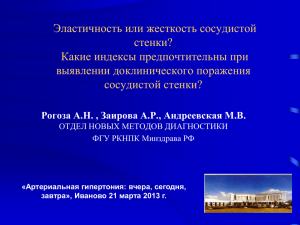
![ионнaя сила c [m m ol/l] p H μr>μ Физико](http://s1.studylib.ru/store/data/002536317_1-d3dcf21869af3ad9327d8f7749f7c309-300x300.png)
